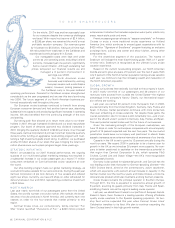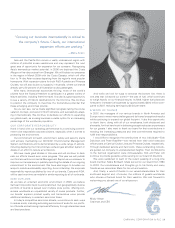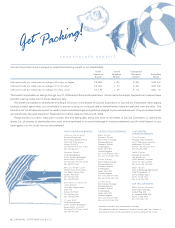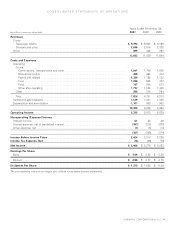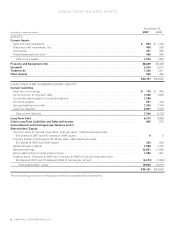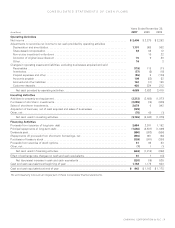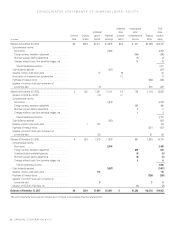Carnival Cruises 2007 Annual Report Download - page 15
Download and view the complete annual report
Please find page 15 of the 2007 Carnival Cruises annual report below. You can navigate through the pages in the report by either clicking on the pages listed below, or by using the keyword search tool below to find specific information within the annual report.NOTES TO CONSOLIDATED FINANCIAL STATEMENTS (continued)
12 | CARNIVAL CORPORATION & PLC
Insurance/Self-Insurance
We use a combination of insurance and self-insurance for
a number of risks including claims related to crew and guests,
hull and machinery, war risk, workers’ compensation, property
damage and general liability. Liabilities associated with certain
of these risks, including crew and guest claims, are estimated
actuarially based on, among other things, historical claims
experience, loss development factors and other assumptions.
Our expected loss accruals are based on estimates, and while
we believe the amounts accrued are adequate, the ultimate
loss may differ from the amounts provided.
Selling and Administrative Expenses
Selling expenses include items such as advertising, mar-
keting, promotional and related costs. Advertising costs are
charged to expense as incurred except for brochures and
media production costs. The brochures and media production
costs are recorded as prepaid expenses and charged to
expense as consumed or upon the first airing of the advertise-
ment, respectively. Advertising expenses totaled $508 million,
$464 million and $455 million in fiscal 2007, 2006 and 2005,
respectively. At November 30, 2007 and 2006, the amount of
advertising costs included in prepaid expenses was not sig-
nificant. Administrative expenses represent the costs of our
shoreside ship support, reservation and other administrative
functions and include items such as salaries and related bene-
fits, professional fees and occupancy costs, which are typi-
cally expensed as incurred.
Foreign Currency Translations and Transactions
We translate the assets and liabilities of our foreign sub-
sidiaries that have functional currencies other than the U.S.
dollar at exchange rates in effect at the balance sheet dates.
Revenues and expenses of these foreign subsidiaries are
translated at weighted-average exchange rates for the period.
Equity is translated at historical rates and the resulting cumu-
lative foreign currency translation adjustments are included
as a component of AOCI. Therefore, the U.S. dollar value of
these non-equity translated items in our financial statements
will fluctuate from period to period, depending on the chang-
ing value of the dollar against these non-U.S. dollar functional
currencies.
Exchange gains and losses arising from the remeasurement
of monetary assets and liabilities, and foreign currency trans-
actions denominated in a currency other than the functional
currency of the entity involved are immediately included in
nonoperating earnings, unless such assets and net liabilities
have been designated to act as hedges of ship commitments
or net investments in our foreign subsidiaries, respectively. In
addition, the unrealized exchange gains or losses on our long-
term intercompany receivables denominated in a non-functional
currency, which are not expected to be repaid in the foresee-
able future and are therefore considered to form part of our
net investments, are recorded as a foreign currency translation
adjustment, which is included as a component of AOCI. Net
foreign currency transaction gains or losses recorded in our
earnings were insignificant in fiscal 2007, 2006 and 2005.
Earnings Per Share
Basic earnings per share is computed by dividing net income
by the weighted-average number of shares of common stock
and ordinary shares outstanding during each period. Diluted
earnings per share is computed by dividing adjusted net
income by the weighted-average number of shares of com-
mon stock and ordinary shares, common stock equivalents
and other potentially dilutive securities outstanding during each
period. For earnings per share purposes, Carnival Corporation
common stock and Carnival plc ordinary shares are considered
a single class of shares because of their equivalent rights (see
Note 3). All shares that are issuable under our outstanding
convertible notes that have contingent share conversion
features have been considered outstanding for our diluted
earnings per share computations, if dilutive, using the “if
converted” method of accounting from the date of issuance.
Share-Based Compensation
Effective December 1, 2005, we adopted the provisions of
Statement of Financial Accounting Standard (“SFAS”) No. 123
(revised 2004), “Share-Based Payment” (“SFAS No. 123(R)”),
which requires us to measure and recognize compensation
expense for all share-based compensation awards. We adopted
SFAS No. 123(R) using the modified prospective application
transition method. Under this method, the share-based com-
pensation cost recognized beginning December 1, 2005
includes compensation cost for (i) all share-based payments
granted prior to, but not vested as of, December 1, 2005,
based on the grant date fair value originally estimated in accor-
dance with the provisions of SFAS No. 123, “Accounting for
Stock-Based Compensation” (“SFAS No. 123”), and (ii) all
share-based payments granted subsequent to November 30,
2005, based on the grant date fair value estimated in accord-
ance with the provisions of SFAS No. 123(R). Prior to
December 1, 2005, as allowed under the then outstanding
accounting principles, we did not recognize compensation
expense for the issuance of stock options with an exercise
price equal to or greater than the market price of the under-
lying shares at the date of grant.


